2021 Kawasaki ZX-10R Review - First Ride

A sharper weapon to ensure one man's success
What Johnny Rea wants, Johnny Rea gets. That’s the kind of pull you have when you become the most dominant rider in World Superbike history and help Kawasaki become the dominant manufacturer from the moment you join the team. It’s also the short history behind the latest incarnation of the Kawasaki ZX-10R for 2021. It’s not a new motorcycle from the ground up, but comes with some significant revisions over the previous model to help Johnny keep one step ahead of the chasing pack.
2021 Kawasaki ZX-10R
| Engine | 17.0/20 |
| Suspension/Handling | 13.0/15 |
| Transmission/Clutch | 9.0/10 |
| Brakes | 8.0/10 |
| Instruments/Controls | 4.0/5 |
| Ergonomics/Comfort | 7.0/10 |
| Appearance/Quality | 9.0/10 |
| Desirability | 8.0/10 |
| Value | 9.0/10 |
| Overall Score | 84/100 |
Of course, once you reach the top like Rea and Kawasaki have, others want to bring you down. In this case the threat has come from a certain red Italian rival with a fire-breathing V4 stuffed under its fairings. They’ve been biting at the heels of Rea’s Kawasaki ZX-10R, so with his help Kawi has gone back to the drawing board to give him an even more potent weapon for 2021. With World Superbike rules being the way they are, basic improvements to the race bike have to start as improvements to the street bike. In theory, not only does Johnny benefit – we all do!
It’s not exactly a one-to-one relation, though, as I’ll explain later. First, let’s go over the myriad of changes.
Styling
It’s customary to start talking about the engine when it comes to changes on a motorcycle, but when a new model comes out looking as, um, interesting, as the ZX-10R it’s hard not to start anywhere else. Let’s just get right down to it – this is the very definition of having a face only a mother could love. I know I’m the last person to be doling out style advice, but looking at the nose of the motorcycle from the side profile it looks like it has a slight underbite. Granted, the head-on profile isn’t as offensive, but rightly or wrongly, flagship sportbikes are supposed to leave people in awe of their beauty. In this case, people are left in awe alright. But maybe not for the right reasons.
However you or I feel about the polarizing looks of the ZX-10R, one thing hasn’t changed – the prioritizing of function over form. The revised nose cowling now offers 7% less drag and about 17% more downforce from the integrated winglets incorporated into the design. As much as I’ve just bagged on the Kawasaki’s looks, I do give the design team credit for incorporating the winglets that have become so popular on current sportbikes instead of simply tacking them onto the side.
For what it’s worth, the gaping mouth appearance of the new nose has let Kawasaki place the new LED headlights from Mitsubishi underneath the upper cowl. These new lights are super small and compact, weighing 450g less than the previous model. Better still, when the bike is turned on and the lights are beaming, I’ll admit it does add a bit of attitude to the 10R’s appearance.
More than just change for change’s sake, the redesigned ram-air duct doesn’t lose any of its efficiency or volume compared to the previous model, and the lower portion of the cowl helps direct air to the new, independent oil cooler, which is covered in more detail later.
Engine
OK, with the styling out of the way, let’s talk about the 998cc inline-Four cylinder engine. It is not new for 2021, but it’s been a minute since we’ve given it attention. Super short pistons help reduce weight, minimize drag, and its 13.0:1 compression ratio ensures maximum squeeze before combustion occurs. There’s a lot going on before the bang happens, though, as the cylinder head is designed for maximum efficiency – and the option to fit (and optimize) Kawasaki’s kit race parts – including camshafts, stronger valve springs, race ECU, and over 70 other parts – should you choose.
The intake charge is designed to flow in as straight a path as possible for the best efficiency and as large a volume as possible in the combustion chamber. All four valves are titanium for maximum lightness, a necessity for reaching a high rev ceiling. Speaking of high rev ceilings, the finger-follower valve train results in a 20% reduction in reciprocating mass compared to tappet-style valve actuation, which helps the ZX-10R reach its 14,500rpm redline. Big power also creates lots of heat. The ZX-10 incorporates large coolant passages to help keep things, well, cool.
This brings us to one of the new changes to the 2021 model based on the feedback from KRT – an independent, air-cooled oil cooler that is now a completely separate circuit from the previous model which piggybacked engine coolant through the main radiator before cooling the oil circuit as well.
Moving deeper into the engine, the internal gearing for the six-speed transmission has been changed. Even lowly motojournos like ourselves have commented about how extremely tall ZX-10Rs have been geared, and even though race teams can easily change internal gearing themselves, now the change has come down the line to the production model, too. Overall, the final gearing sees a 41-tooth rear sprocket, up two teeth from before. Internally, first, second, and third gears are all shorter to help with acceleration and to get a better drive.
Spent exhaust gases make their way out from the titanium-alloy header pipes and silencer, but the configuration of the exhaust is tweaked for 2021, partially to help meet Euro 5 regulations. Not only are the catalysers further forward to help burn off exhaust gasses quicker, the pre-chamber volume is reduced while the silencer itself grows a little to make up for it. Kawasaki also rearranged the exhaust header crossover pipes so cylinders 1 and 2 are connected and cylinders 3 and 4 are connected. Previously, it was 1-4 and 2-3.
Electronics
A big change for 2021is the fully ride-by-wire throttle. Cables were still used in the 2020 model, but with the ever-advancing electronics race, simply relocating the throttle position sensor was all it took to get rid of the throttle cable and switch to a fully electronic throttle. Now friction is used to simulate the feel of a cable.
As we all know, modern superbikes today are nothing without electronics, and as mentioned the switch to a full R-b-W system enables integration of Kawasaki’s most sophisticated electronics suite to date. At the heart of it, of course, is a Bosch IMU monitoring longitudinal, transverse, and vertical axes, along with roll and pitch. The sixth axis, yaw, is then calculated via proprietary Kawasaki software. Also, as a convenient byproduct of a cable-less throttle, the ZX-10R now has cruise control(!)
The ZX-10R has had an electronics suite for a while now, of course, but the new updates have reorganized how Kawasaki configures the four riding modes – Sport, Road, Rain, and Rider. The first three are pre-programmed with specific power and traction control settings; Sport mode offers full power and the least amount of TC, Road also gives you full power but places TC in level three (of five), while Rain mode limits power to Low mode and places TC in level five, the maximum.
Rider mode is completely customizable, allowing the user to choose any of the three power modes (Full, Medium – 80% of full, or Low – 60% of full) and any of the six TC settings (1-5, and off). Kawasaki also revised TC levels 4 and 5 to be more intrusive and better suited for poor riding conditions. Within Rider mode there are four presets you can customize, making for a total of seven modes altogether.
S-KTRC (Sport-Kawasaki Traction Control) is part of a larger whole called Kawasaki Cornering Management Function (KCMF), which looks at the engine and chassis’ behavior throughout the entire corner – from entry, to the apex, to the exit – and manages not only the traction control, but also the launch control (KLCM) and Kawasaki Intelligent Anti-Lock Brake System (KIBS).
Keeping tabs on all of the bike’s functions is a new 4.3-inch full-color TFT screen that can easily be switched to either a white or black background, in either race or street modes. You’ll find all the usual displays there like speedo, tach, gear position, etc., but it also has a Bluetooth chip built in to connect the bike to Kawasaki’s Rideology app which displays vehicle info like the date of last service and when you should change your oil next.
Perhaps the more interesting features of the Rideology app are the riding logs and tuning abilities it can perform. With the former, the app can use your phone’s GPS to map your ride. If you’re at a circuit, it can build a map of the track and chart your laps, giving you information like speed, RPM, gear position, and more at any specific point on track. The tuning function lets you adjust things like the power settings or TC settings, then once the motorcycle is turned on and synced back with your phone, it will adopt those changes.
Chassis/Ergonomics
On the chassis side, the focus was to put more weight on the front tire and move the balance of the bike more forward. Since this isn’t an all-new bike, the primary frame and swingarm are the same as before, but there are still some tricks available to adjust a motorcycle’s geometry.
The swingarm pivot is now 1mm lower than the previous model, and even though the swingarm itself is the same length as before, the rear tire is pushed back 8mm in the chain adjustment range. At the same time the fork offset also lengthened 2mm to create an overall 10mm longer wheelbase (from 1440mm to 1450mm, or 56.7 inches to 57.1 inches). The front/rear balance also moves forward a tiny 0.2%.
Suspension-wise, you’ll continue to find the 43mm Showa Balance Free Front Fork (BFF), using technology borrowed directly from World Superbike. In short, the fork isolates the damping forces in the secondary, pressurized chamber, leaving the main fork body open for the piston to push oil towards the valves. It’s fully adjustable, of course, and both the compression and rebound circuits are completely independent of each other.
In 2021 trim, the fork now gets a softer spring (from 21.5 N/mm to 21.0 N/mm) with firmer compression damping and softer rebound damping, again in an effort to put more weight and feeling on the front tire. The lower triple clamp has changed and now distributes its clamping force over a wider surface area.
You’ll still find the Showa Balance Free Rear Cushion (BFRC), which is Showa’s weird term for a shock. The clever arrangement of the linkage due to the shock’s horizontal placement keeps the packaging compact near the frame. This lets the upper shock mount be placed further away from the swingarm pivot for better chassis rigidity, while also creating more space between the shock and the hot exhaust for more stable performance. Like the fork, the shock gets some slight tweaks. To offset the softer spring, the shock gets a slightly firmer spring (91 N/mm to 95 N/mm). Both compression and rebound damping are softened, too. This helps to induce pitch to the front.
More than just a facelift, the ergonomics of the 2021 10R have changed, too. Starting at the front, the windscreen has grown 40mm taller and is set at a steeper angle, putting the rider in a bigger bubble while tucked. The handlebar position has changed and is now 10mm further forward. Its angle is reduced, too, making for a straighter bar. Footpegs have been raised 5mm, and the rear section of the seat is also elevated higher. The combination of these changes puts the rider in a more aggressive position when fully tucked in.
ZX-10RR
Let’s not forget the double-R ZX-10. Being produced in a very limited quantity of 500 units worldwide, the ZX-10RR is even more race focused. It already includes all the upgrades and updates seen on the single-R, but now comes with Pankl pistons that are each 20 grams lighter. The pistons also use one less piston ring than the standard model, allowing for a shorter piston and reducing loss due to friction. Speaking of friction, the piston pins are matched to the individual piston and receive a Diamond Like Coating to give maximum protection against wear.
The RR gets more aggressive camshafts that favor high-rpm performance. To cope with this, all four valve springs are machined to match the valve spring containers for better high-rpm reliability. In a further nod towards high-revving power, the variable lengths of the intake funnels in the airbox are gone, replaced with 5mm funnels across the board. Finally, the RR gets steel brake lines to reduce lever slop and seven-spoke forged Marchesini aluminum wheels wrapped in Pirelli Supercorsa SP tires.
For the serious racer looking at building a ZX-10R (or RR), the Kawasaki race parts catalog has more than 70 parts to transform the ZX-10, including the Race kit ECU, offset steering head collars and swingarm pivots, and of course numerous engine and chassis parts to fine tune the steed for more power and better handling.
Ride Impressions
All of this leads us to the main question: What’s it like to ride? It’s at this point I’m left with a bit of a conundrum. The target with the new ZX-10 was to make an evolution of the previous bike with more power, better electronics, more front-end bias, and better aerodynamics than the old one. They’ve done that. But is it necessarily better?
Auto Club Speedway in Fontana, California would be our testing grounds for the 10R. Basically a road course built inside a NASCAR oval, the former AMA circuit is the only track in Southern California where a motorcycle this powerful can stretch its legs in sixth gear as it roars along the banking. And roaring is where it likes to be, as the engine clearly comes alive beyond about 9000 rpm. This is all the more surprising considering the altered state of tune standard bikes are forced to have due to EPA regulations. In US tune the 10R would rev to its 14,500 rpm redline, but the power plateaus after about 12,000 or so.
Still, with such a peaky powerband, it’s all you can do to keep the engine singing no matter what. Dip into the midrange and the power is lackluster until the revs hit the pipe, then you’re suddenly blasted on your way. To make matters worse, the Ride-by-Wire throttle is extremely sensitive and touchy. Careful throttle application is a must on all literbikes anyway, but this is especially true with the new 10R. Even the steadiest of hands don’t stand a chance against the bike’s tendency to buck and surge. I’m used to this on some bikes, and often changing to a different, softer, power mode cures the touchiness. Not so with the Zed. In both Medium and Low power settings, initial throttle is still touchy.
Adding to the awkwardness is the ability of the throttle tube to over-rotate, which is one of the ways to disable cruise control. Usually you can count on the throttle reaching a hard stop when you let off. I didn’t realize how vital this hard stop was when trying to decide how much gas to reapply. Thankfully the up/down quickshifter works well at race pace (it’s a little notchy at mid-revs), so having to rev match isn’t an issue. However, if you did have to manually downshift and rev match for any reason, it would be just that little bit trickier.
All the twitchiness aside, it’s still a powerful machine. Get it in its sweet spot and the rush of power is addicting – I saw 175 mph (indicated) on the dash before having to tap down to fifth and tip it into Auto Club’s Turn 1. Considering the neutered state of tune to appease the Feds, I can only imagine what a flashed (or European) bike would feel like when the throttle plates are allowed to open fully.
Granted, it’s been some time since I rode the last ZX-10R, so those distant memories make direct comparisons difficult. However, just the week prior I spent a day riding Yamaha’s new R7. No, the two bikes aren’t anywhere near the same league, but it did give me some perspective. First, come the ergonomics. Where the R7 feels small and compact, the ZX-10 unsurprisingly feels large.
This is obviously to be expected, but the difference comes with the placement of the rider triangle. The straight bars of the Kawasaki, now further forward, never felt comfortable to me. The longer reach placed more weight on my wrists under braking. Combined with the straighter angle of the bars, and it actually was less comfortable to get my body into position to turn – especially so during side-to-side transitions. Granted, in a tuck the new position does feel pretty spacious. The extra wind protection from the taller screen was welcomed, too. Since ergonomics are a very personal thing, those taller than my 5-foot, 8-inch frame might feel differently about the setup.
To Kawasaki’s credit, handling from the new chassis changes results in a very neutral-feeling bike. Basic suspension adjustments yielded noticeable changes each time, but unlike past ZX-10s, which basically required a shim placed in the shock to raise rear ride height, the new ones we rode didn’t have them. Kawasaki said the new placement of the swingarm pivot negated the need. However, some 2mm shims were available, and for the sake of science I was curious to try them to see if I could feel any difference. It’s as though Kawasaki planned ahead for the install of these shims, too, as save for some fumbling to disconnect emissions-related components racers will toss anyway, it seemed very easy to pop off the gas tank, reach the shock mount, and install the shim.
Ultimately, the difference translates to the bike tipping in slightly faster and finishing the corner with less effort and input from the rider. Both are nice things. While it doesn’t give the same kind of ultimate front-end confidence of, say, the Aprilia RSV4, the Kawasaki’s chassis is very balanced. Softening the front while firming up the rear doesn’t sound like much of a change – and it isn’t – but it’s enough to give it a noticeably greater pitch over the front than I remember before.
While I didn’t expect a middleweight Twin like the R7 to give me much insight into a superbike like the ZX-10, riding them a week apart highlights exactly what the term “usable power” means. The R7 will be lucky to make 50 lb-ft of torque on a good day, but the way it delivers its power via a strong and healthy midrange gives the impression that you’re really scooting along and getting the most out of the motorcycle.
Conversely, twisting the grip while in the Kawi’s midrange just results in anxiety. There’s not much forward motion, but you know it’s coming. When it does, you better be ready. It’s times like this when it’s nice to have a sophisticated safety net in the form of traction control to help catch that inevitable hit. It’s at this point it’s worth confessing about the Bridgestone V02 slick tires equipped to our test bikes for this test. Standard tires are the Bridgestone Hypersport S22. Still, with only five settings (and the last two being restrictive for street riding), more than one tester had out-of-seat moments spinning up the slicks in TC down at 1. Even when practicing caution, my right wrist could get the rear to spin at a decent lean angle.
No TC system is completely crash proof, but at low settings the Kawi’s TC snaps more abruptly than I expected, easily enough to still crash the bike if you aren’t careful. Having an IMU is great, but having the right software to support it is better. There are a couple sections at Auto Club where the exit of a corner opens and you’re laying down darkies in an effort to get as much drive as possible. With the 10R’s traction control system set low, the trick, albeit an advanced one, was to stomp the rear brake while giving it the berries.
Adding a little extra annoyance is the combination of button presses you need to make to change settings. While other bikes let you change TC settings on the fly with some button taps, the ZX-10 requires a closed throttle and a series of button holds combined with taps – there’s no way it could be done on the fly. At least the TFT screen is bright and colorful…
Thanks to European regulations KIBS (aka ABS) is always on, but it’s easily defeated by pulling a fuse, which is how the bikes we tested were set up. For the purposes of track testing on this particularly gorgeous Southern California day, and with the swap for slick tires, reaching the ABS threshold would have happened early and often.
As it were, the Brembo radial master cylinder combined with the M50 calipers and 330mm discs offered excellent braking power. They were only let down by the rubber lines holding the system together, as the sponginess from the lever was readily apparent. It feels cheap to equip such a top level sportbike with rubber lines, and it is. Unless you want to pop for the $28,999 ZX-10RR, the single R, and its lesser price tag, rubber lines will have to do. How much less? Prices start at $16,399 for non-ABS models and climb to $17,699 for the KRT Edition with ABS.
Final Thoughts
Well, that was strange. The Kawasaki ZX-10R in US trim isn’t nearly as egregious an offender as other models in its class when it comes to how choked the ECU tuning is, but riding it leaves me wondering how much smoother and powerful it would be when left to perform as Kawasaki engineers intended.
Nonetheless, what we have is still an incredibly fast motorcycle with throttle sensitivity issues and ergonomic changes others might find comfortable, but I personally do not. The engine rips once you let it sing, and the revised chassis changes work well, with a nice balanced feel from tip-in to max lean. Were it mine, rubber lines, an ECU flash, and getting the bike comfortable for my tastes would be among the first things I’d do.
However, with how popular – and successful – the ZX-10 is in MotoAmerica Stock1000 racing and other similar series around the world (not to mention Johnny Rea’s continued success with it), it doesn’t matter a whole lot what I think of the bike. Racers are doing well on it already, and Kawasaki is offering a considerable amount of money if you’re able to win on it. There’s even $2000 you might be eligible for right off the bat if you’re buying a 10R for racing purposes. If you’ve been on the fence, that might have been the push you needed. Otherwise, if you do like the looks of the new nose, then go for it. None of the bikes in this class are ones mere mortals like us can get the most out of. So, pick the one most attractive to you.
2021 Kawasaki ZX-10R
+ Highs
- Get that engine screaming, and it’s a ripper
- Neutral and balanced chassis
- Best electronics on a ZX-10R so far
– Sighs
- Not much in terms of midrange (at least in US tune)
- Very twitchy throttle/fueling
- Ergos not to my liking (but might be to yours)
In Gear
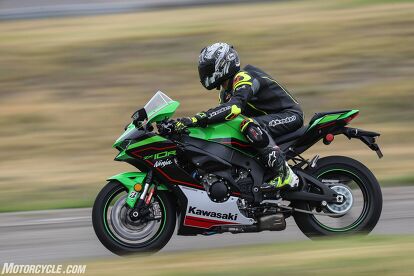
Helmet: Arai Corsair-X Kiyonari
- Suit: Alpinestars GP Pro V2
- Airbag: Alpinestars Tech-Air Race
- Gloves: Alpinestars GP Pro V3
Boots: Alpinestars Supertech-R
2021 Kawasaki Ninja ZX-10R Specifications | |
|---|---|
| MSRP | $16,399 (ZX-10R) $16,699 (KRT Edition) $17,399 (ZX-10R ABS) $17,699 (KRT Edition ABS) $28,999 (ZX-10RR) |
| Engine Type | 4-stroke, In-Line Four, DOHC, 16-valve, liquid-cooled |
| Displacement | 998cc |
| Bore x Stroke | 76.0 x 55.0mm |
| Compression Ratio | 13.0:1 |
| Fuel System | DFI w/47mm Mikuni throttle bodies (4) with oval sub-throttles, two injectors per cylinder |
| Ignition | TCBI with digital advance and Sport-Kawasaki Traction Control (S-KTRC) |
| Transmission | 6-speed, return shift |
| Final Drive | Sealed chain |
| Electronic Rider Aids | Electronic Cruise Control, Kawasaki Launch Control Mode (KLCM), Kawasaki Intelligent anti-lock Brake System (KIBS), Kawasaki Sport Traction Control (S-KTRC), Kawasaki Engine Braking Control, Kawasaki Quick Shifter (KQS) (upshift & downshift), Kawasaki Corner Management Function (KCMF) |
| Frame Type | Aluminum perimeter |
| Front Suspension | 43mm inverted Balance Free Fork, adjustable stepless rebound and compression damping, spring preload adjustability/4.7 in |
| Rear Suspension | Horizontal back-link with Balance Free gas-charged shock, stepless, dual-range (low-/high-speed) compression damping, stepless rebound damping, fully adjustable spring preload/4.5 in |
| Front Brakes | Intelligent Braking (KIBS) (ABS only), Brembo dual semi-floating 330mm discs with dual radial mounted monobloc 4-piston calipers |
| Rear Brakes | KIBS-controlled (ABS only), single 220mm disc with aluminum single-piston caliper |
| Front Tire | 120/70 ZR17 |
| Rear Tire | 190/55 ZR17 |
| Rake/Trail | 25.0°/4.1 in |
| Overall Length | 82.1 |
| Overall Width | 29.5 |
| Overall Height | 46.7 |
| Ground Clearance | 5.3 |
| Seat Height | 32.9 in |
| Curb Weight | 456.4 lb (claimed) |
| Fuel Capacity | 4.5 gal |
| Wheelbase | 57.1 |
| Special Features | Aerodynamic Downforce Generating Devices, Rideology the App Smartphone Connectivity, TFT Instrumentation |
| Color Choices | Metallic Spark Black / Metallic Matte Carbon Gray |
| Warranty | 12 Month Limited Warranty |
| Kawasaki Protection Plus (optional) | 12, 24, 36 or 48 months |
We are committed to finding, researching, and recommending the best products. We earn commissions from purchases you make using the retail links in our product reviews. Learn more about how this works.
Become a Motorcycle.com insider. Get the latest motorcycle news first by subscribing to our newsletter here.

Troy's been riding motorcycles and writing about them since 2006, getting his start at Rider Magazine. From there, he moved to Sport Rider Magazine before finally landing at Motorcycle.com in 2011. A lifelong gearhead who didn't fully immerse himself in motorcycles until his teenage years, Troy's interests have always been in technology, performance, and going fast. Naturally, racing was the perfect avenue to combine all three. Troy has been racing nearly as long as he's been riding and has competed at the AMA national level. He's also won multiple club races throughout the country, culminating in a Utah Sport Bike Association championship in 2011. He has been invited as a guest instructor for the Yamaha Champions Riding School, and when he's not out riding, he's either wrenching on bikes or watching MotoGP.
More by Troy Siahaan



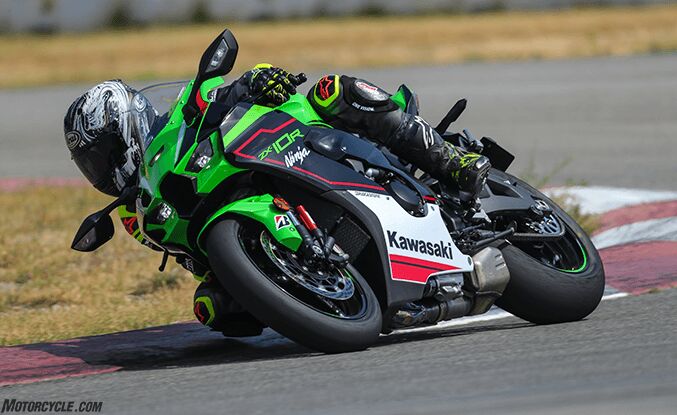























































































































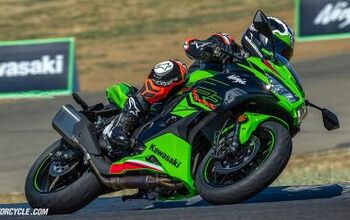
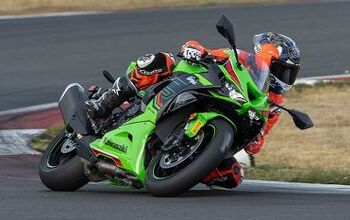
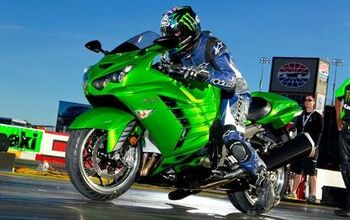












Comments
Join the conversation
Don’t quite get the color scheme on the green/black/red/white version.
I wonder how that made it through the product planning stages.
The aerodynamics may have more to them than meets the eye. Check out this article: https://speedeej.com/2021-k...